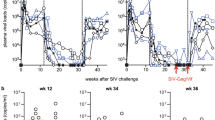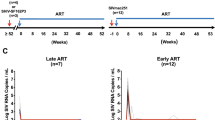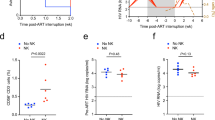Abstract
Simian immunodeficiency virus (SIV) infection of nonhuman primates is one of the most relevant animals models of HIV infection in humans. To test a potential anti-HIV gene therapy strategy in this model, CD4-enriched lymphocytes from three rhesus macaques were subjected to retrovi-rally mediated gene transfer with a vector expressing an antisense tat/rev gene. This group of animals and three control macaques were subsequently infected with SIVmac239. Blood and lymph nodes from all macaques were sampled for more than a year to monitor the progress of infection. Although all animals became infected, the animals that received the lymphocytes engineered with the antisense vector demonstrated a significant reduction in viral load in both peripheral blood and lymph nodes, had sustained numbers of CD4+ cells, and exhibited little disruption of lymph node architecture.
This is a preview of subscription content, access via your institution
Access options
Subscribe to this journal
Receive 12 print issues and online access
$209.00 per year
only $17.42 per issue
Buy this article
- Purchase on Springer Link
- Instant access to full article PDF
Prices may be subject to local taxes which are calculated during checkout
Similar content being viewed by others
References
Baltimore, D. Intracellular immunization. Nature 335, 395–397 (1988).
Vanden Driessche, T., Chuah, M.K.L., Chang, H.-K. Ensoli, B. & Morgan, R.A. Inhibition of clinical human immunodeficiency virus (HIV) type 1 isolates in primary CD4 T lymphocytes by retroviral vectors expressing anti-HIV genes. J. Virol. 69, 40–45 (1995).
Trono, D., Feinberg, M.B. & Baltimore, D. HIV-1 gag mutants can dominantly interfere with the replication of the wild-type virus. Cell 59, 113–120 (1989).
Woffendin, C., Rangs, U., Yang, Z.-Y. Xu, L. & Nabel, G.J. Expression of a protective gene prolongs survival of T cells in human immunodeficiency virus-infected patients. Proc. Natl. Acad. Sci. USA 93, 2889–2894 (1996).
Morgan, R.A. & Walker, R. Gene therapy for AIDS using retroviral mediated gene transfer to deliver HIV-1 antisense TAR and transdominant Rev protein to syn-geneic lymphocytes in HIV-1 infected identical twins. Hum. Gene Then 7, 1281–1306 (1996).
Ensoli, B., Barillari, G., Salahuddin, S.Z., Gallo, R.C. & Wong-Stall, F. Tat protein of HIV-1 stimulates growth of cells derived from Kaposi's sarcoma lesions of AIDS patients. Nature 344, 84–86 (1990).
Banda, N.K. et al. Crosslinking CD4 by human immunodeficiency virus gp120 primes T cells for activation-induced apoptosis. J. Exp Med. 176, 1099–1106 (1992).
Gardner, M.B., Endres, M. & Barry, P. The simian retroviruses: SIV and SRV. in The Retroviridae. The Viruses, Vol. 3 (ed. Levy, J.A.) 133–276 (Plenum Press, New York, 1994).
Kindt, T.J., Hirsch, V.M., Johnson, P.R. & Sawasdikosol, S. Animal models for acquired immunodeficiency syndrome. Adv. Immunol. 52, 425–474 (1992).
Bunnell, B.A., Metzger, M., Byrne, E., Morgan, R.A. & Donahue, R.E. Efficient in vivo marking of primary CD4 T lymphocytes in nonhuman primates using a gibbon ape leukemia virus-derived retroviral vector. Blood 89, 1987–1995 (1997).
Endres, C.L., Bergquam, E.P., Axthelm, M.K. & Wong, S.W. Suppression of simian immunodeficiency virus replication by human immunodeficiency virus type 1 trans-dominant negative rev mutants. J. Virol. 69, 5164–516 (1995).
Bunnell, B.A., Muul, L.M., Donahue, R.E., Blaese, R.M. & Morgan, R.A. High-efficiency retroviral mediated gene transfer into human and nonhuman primate peripheral blood lymphocytes. Proc. Natl. Acad. Sci. USA 92, 7739–7743 (1995).
Siekevitz, M. et al. Activation of the HIV-1 LTR by T cell mitogens and the trans-activator protein of HTLV-I. Science 238, 1575–1578 (1992).
Levine, B.L. et al. Antiviral effect and ex vivo CD4 T cell proliferation in HIV-positive patients as a result of CD28 costimulation. Science 272, 1939–1943 (1996).
Lohman, B.L. et al. A partially attenuated simian immunodeficiency virus induces host immunity that correlates with resistance to pathogenic virus challenge. J. Virol. 68, 7021–7029 (1994).
Kestler, H.W. et al. Importance of the nef gene for maintenance of high virus loads and for development of AIDS. Cell 65, 651–662 (1991).
Haigwood, H.L. et al. Passive immune globulin therapy in the SIV/macaque model: Early intervention of immunodeficiency and immunosuppression. Immunol. Lett. 51, 107–114 (1996).
Pantaleo, G. How immune-based interventions can change HIV therapy. Nature Med. 3, 483–486 (1997).
Donahue, R.E. et al. Peripheral blood CD34+ cells differ from bone marrow CD34+ cells in Thy-1 expression and cell cycle status in nonhuman primates mobilized or not mobilized with granulocyte colony-stimulating factor and/or stem cell factor. Blood 87, 1644–1653 (1996).
Clements, J.E. et al. Cross-protective immune responses induced in rhesus macaques by immunization with attenuated macrophage-tropic simian immunodeficiency virus. J. Virol. 69, 2737–2744 (1995).
Mankowski, J.L. et al. Neurovirulent simian immunodeficiency virus replicates productively in endothelial cells of the central nervous system in vivo and in vitro. J. Virol. 68, 8202–8208 (1994).
Laird, N.M. & Ware, J.H. Random-effects models for longitudinal data. Biometrics 38, 963–974 (1982).
Author information
Authors and Affiliations
Rights and permissions
About this article
Cite this article
Donahue, R., Bunnell, B., Zink, M. et al. Reduction in SIV replication in rhesus macaques infused with autologous lymphocytes engineered with antiviral genes. Nat Med 4, 181–186 (1998). https://doi.org/10.1038/nm0298-181
Received:
Accepted:
Issue Date:
DOI: https://doi.org/10.1038/nm0298-181
This article is cited by
-
Inhibition of HIV-1 replication by novel lentiviral vectors expressing transdominant Rev and HIV-1 env antisense
Gene Therapy (2002)
-
Antisense RNA sequences targeting the 5′ leader packaging signal region of human immunodeficiency virus type-1 inhibits viral replication at post-transcriptional stages of the life cycle
Gene Therapy (2000)



